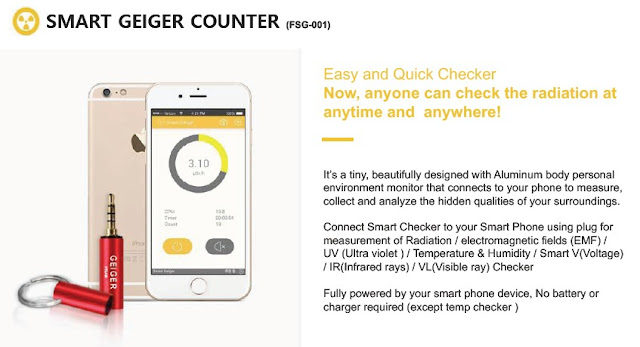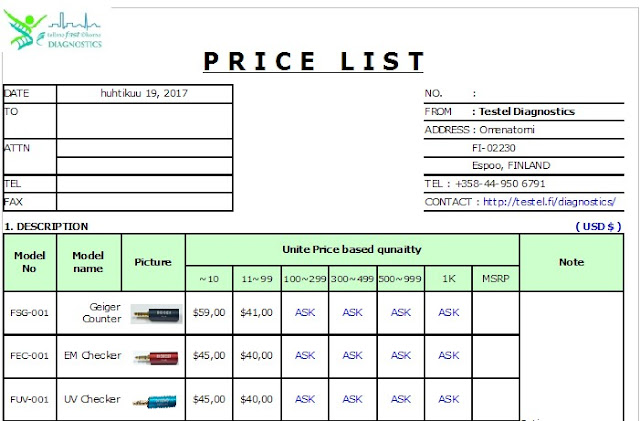Pocket Geiger counter for Smartphones
Remember Chernobyl disaster on 1986 and Fukushima on 2011
Fukushima fallout on air on 2011
Fukushima fallout on the Pacific Sea (Enenews)
Almost all bottom trawled fish as pollock, salmon and
herring are typically contamined by radioactive Cesium 137.
DIGITAL | TECHNOLOGY | FUKUSHIMA INNOVATION.
PATENTED, CE and ROHM certified.
Smart Geiger Nuclear Radiation Gamma X-ray Personal Detector Counter Tester Sensor for Smartphone Apple iPhone 4, 4s, 5, 5s, 6, iPad, etc.
Android Phone Samsung Galaxy S3, S4, S5, S6, Note 3, Lg, G, G2, G3, G App, etc.
Personal Geiger Monitor for Smartphone Anytime, Anywhere
No more worries on radioactivity for my family
You can easily check the danger of radioactivity just place it near
the suspicious object!
No more worries on radioactivity for my family
the suspicious object!
Product Features
Smart Geiger is a sub-miniature sensor of cheap price which can detect radioactivity easily and conveniently by connecting to the earphone jack of a smart phone.
It indicated radiation coming out from a radioactive substance in dose-rate figure (uSv/h) and informs even by sound, using semiconductor sensor.
The measurement error is approx. within 30% because there are many different kinds of smart-phones in the market.
Therefore, you may leave the exact measurement of radiation dose to experts, and you can carry out preliminary simple measurement by inserting Smart Geiger into the smart-phone.
Smart Geiger is manufactured by R&D specialized company, FT Lab with a sense of mission, which has obtained 3 New Technology Certifications during the last 14 years of its R&D career.
Compatible with iPhones and Android- phones. SMART GEIGER COUNTER (FSG-001)
Easy and Quick Checkers
Now, anyone can check the radiation at anytime and anywhere!
It’s a tiny, beautifully designed with Aluminum body personal environment monitor that connects to your phone to measure, collect and analyze the hidden qualities of your surroundings.
Connect Smart Checker to your Smart Phone using plug for measurement of Radiation / electromagnetic fields (EMF) / UV (Ultra violet ) / Temperature & Humidity / Smart V(Voltage)
/ IR(Infrared rays) / VL(Visible ray) Checker Fully powered by your smart phone device, No battery or charger required (except temp checker )
SMART GEIGER COUNTER (FSG-001)
FEATURES
• Handy
• Easy to Carry
• Quick and Accurate Data
• Reasonable Price
• No Battery Needed
FREE Sensor Application
Connect to Smart phone ear jack
Sensor unit (Aluminum)
Connect Jack (Ear Jack)
Smart Geiger is a miniature Geiger Counter.
It detect low levels of hard beta and gamma particles. Running the test for longer than two minutes will yield more accurate results.
Professionally precise. Smart Geiger reveals highly accurate information about the radioactive particles around you and how they might be affecting you.
Item Description
Radiation Measurement Gamma, X-ray
Sensor Type Semiconductor Sensor
Range Survey Meter : 0.1~200 μSv/h
Measurement error < ―15%
Size Length 30mm (include Ear Jack : 47mm), Φ10
Weight 6 g
User Interface Smart Phone ( Earphone Jack)
Material Al (Aluminum)
Linearity 97% at 20 ~ 120 μSv/h
※ Reference testing reports.
SMART GEIGER PRO (SGP-001)
High sensitive and tiny smart Geiger counter that measures even the environmental radiation.
10 times more powerfully upgraded!
More widely, more accurately!
• Measure the environmental radiation with its high sensitive sensor
• Measure the radiation in the air with its wider sensor
• Anyone can easily use it
• Convenient to carry around
• Quick and intuitive measurement
• Reasonable price
WIRELESS GEIGER COUNTER (BSG-001)
Item Description
Main Chip Nordic nRF51822, Bluetooth
Low energy/ 2.4GHz RF system on chip
Chipset ARM Cortex-M0 32bit processor
Function BLE service of the environmental radioactivity
Antenna Pattern Antenna
Sensor type Semiconductor Sensor
Radiation measurement Gamma, X-ray
Measurement rage Survey meter : 0.05~200uSv/h
Measurement error <―15% (minimum error)
WIRELESS GEIGER COUNTER (BSG-001)
Low energy/ 2.4GHz RF system on chip




























 the smaller bluefin (recent migrants from Japan) had 134Cs (0.7 ± 0.2 Becquerels (Bq)/kg) and elevated 137Cs (2.0 ± 0.5 Bq/kg) in their white muscle tissue, while most larger, older fish had no 134Cs and only background levels of 137Cs.1
the smaller bluefin (recent migrants from Japan) had 134Cs (0.7 ± 0.2 Becquerels (Bq)/kg) and elevated 137Cs (2.0 ± 0.5 Bq/kg) in their white muscle tissue, while most larger, older fish had no 134Cs and only background levels of 137Cs.1 